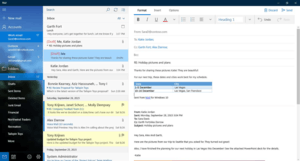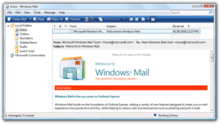Mail (Windows)
Mail is an email client developed by Microsoft and included in Windows Vista and later versions of Windows.[1][2] The main function of Mail is sending and receiving email.[3] It is a successor to Outlook Express, which was either included with or released for Internet Explorer 3.0 and later.
 Mail running on Windows 10 with the light theme | |
| Developer(s) | Microsoft |
|---|---|
| Operating system |
|
| Predecessor | Outlook Express, Windows Live Mail |
| Type | Email client |
Windows Vista

The origins of Windows Mail can be traced back to a pre-release version of Outlook Express 7 included in early builds of Windows Vista, then known by its codename, "Longhorn." This version of Outlook Express introduced various changes to the user interface[4] and relied on WinFS for the management and storage of contacts and other data.[5] While retaining support for Post Office Protocol (POP) and Internet Message Access Protocol (IMAP) email protocols, Outlook Express 7 dropped support for Microsoft's proprietary mail over HTTP scheme.[6]
Windows Mail was announced by Microsoft as the successor to Outlook Express on October 10, 2005, via its community website Channel 9.[7] This initial version featured fundamental changes and a new user interface to match the look and feel of Windows Vista, but not as much in the way of new features.[8] Some interface features were imported from Microsoft Outlook 2003, including the right-hand "reading pane". Microsoft Help Groups has been added, which is a preconfigured link to Microsoft's newsgroups. Some additional functionality has been layered on top of the standard newsgroup functionality to have individual threads be marked as a "question" or an "answered question". Postings may be rated as well. It supports and uses IPv6.[9]
Each mail message is stored in an individual file, instead of in a unified database. A transactional index database (based on the Extensible Storage Engine) enables real-time searching and improves the stability and the reliability of the stored data. In case of corruption, the indices can be rebuilt from the mail files. Account setup information is no longer stored in Windows Registry. It is instead stored alongside the mail itself, making it possible to copy an entire Windows Mail configuration and mail store to another machine in a single step.
Bayesian spam filtering, top-level domain blocking, and encoding blocking have been added. A phishing filter has been incorporated as well, protecting users from web sites that have been identified as being malicious.
Removed features from Windows Mail include:
- Support for WebDAV protocol
- Support for multiple Identities, collection of configurations and email message that could be loaded independent of each other but could be switched at any time[10]
- Support for spell checking dictionaries of Microsoft Office
Windows Mail has a documented application programming interface (API) based on Component Object Model (COM).[11] While its predecessor, Outlook Express, also featured an API, it was undocumented, except for Simple MAPI messaging functionality.[12]
Windows 7
Windows Mail was absent from Windows 7. During this time, Microsoft intended to spin off several Windows components into independently developed apps introduced as part of the Windows Essentials software suite. Thus, Windows Mail was omitted in favor of Windows Live Mail, which was made available for Windows XP, Vista and 7. This policy was partly reverted in Windows 8 and later: The operating system includes a Mail app, which is updated independent of the operating system, through Microsoft Store.
Windows 8.x
Mail was added to Windows 8 as one of many apps written to run full-screen or half-screen, per Microsoft's Metro design language philosophy. It lacks newsgroups support. It is a Windows Store app, and is updated independent of the operating system. It is included in the same app container as Calendar and People. These three cannot be uninstalled or reinstalled separately. Mail in Windows 8 comes with preset server configurations for Outlook.com, Gmail, AOL Mail, and Yahoo! Mail. Other Exchange Server or IMAP accounts can be configured,[13] but it does not directly support POP3. Like many Microsoft apps introduced for Windows 8, many of the features are hidden in the charms or an initially hidden toolbar at the bottom of the screen that is revealed by right-clicking. Users who have subscribed to a Microsoft account can sync all configurations of Mail across different computers. This user interface design was reverted in Windows 10.
Windows 10
Mail has preset server configurations for Outlook.com, Office 365, Gmail, iCloud, and Yahoo! Mail.[14][15][16] AOL Mail, as well as other Exchange Server and IMAP accounts can still be added, and POP3 support has returned.[14][16][17] Newsgroup/Usenet support remains absent.[18] Mail and Calendar are still Universal Windows apps and are in the same app container. But their third sibling, People, is moved out of this container and is a standalone app by itself.
Users can set Windows 10 Mail to use the system theme or choose a custom accent color, background image, and light/dark preference. It has multi-window support and can open email messages in a new window.[19] Emails are listed in Mail's jumplist. Mail uses a settings panel, email sorting tools in the second pane, and a toolbar in the viewing pane. Like the Vista version of Mail, this version's important controls are readily visible. Accounts can be grouped and relabeled, and custom folders can be created, edited or deleted within the app.[20] It is possible to use Outlook.com aliases and @mentions with Mail.
Like Microsoft Outlook, Mail allows users to set up Quick Actions, such as Delete, Set Flag, and Archive, to respond to messages from system notifications and swipe gestures.[21]
As of December 2019, the app displays non-removable advertisements for the Microsoft Outlook mobile app.[22]
Heritage
As with Microsoft Outlook and Outlook Express, Mail uses Ctrl+E to invoke the search. All other Microsoft products use Ctrl+F.
See also
References
- Branscombe, Mary (3 July 2013). "Mail in Windows 8.1: how Microsoft is finally giving it some power". TechRadar. Future US. Retrieved 1 May 2015.
- Warren, Thomas "Tom" (22 April 2015). "Windows 10 preview now includes new Outlook mail app and theme tweaks". The Verge. Vox Media. Retrieved 1 May 2015.
- "Set up Mail and add contacts". Windows Help. Microsoft. Archived from the original on 2013-10-22. Retrieved 2015-08-28.
- Thurrott, Paul. "Windows Longhorn Build 4051 Gallery 3". Supersite for Windows. Archived from the original on 8 January 2015. Retrieved February 9, 2015.
- Jennings, Roger (February 1, 2004). "Get a Grip on Longhorn". MVP Magazine. Retrieved February 9, 2015.
- Lee, Wei-Meng (May 18, 2004). "A First Look at Longhorn". WindowsDevCenter.com. O'Reilly Media. Archived from the original on 26 August 2004. Retrieved February 9, 2015.
- "The new Outlook Express: Windows Mail demoed". Channel9.msdn.com. 2005-09-16. Retrieved 2013-07-29.
- Piltzecker, Tony (April 11, 2007). "Vista Mail vs. Outlook Express". Datamation. Retrieved February 9, 2015.
- "UNINETT: IPv6hostswindows". Archived from the original on 2008-02-27.
- "E-mail identities in Windows Mail". Windowshelp.microsoft.com. Retrieved 2013-07-29.
- "Windows Mail Programmability". Msdn2.microsoft.com. 2011-06-30. Retrieved 2013-07-29.
- "Developer Support Limitations with Outlook Express". Support.microsoft.com. 2005-06-25. Retrieved 2013-07-29.
- "Set up iCloud mail account on the Windows 8 mail app". 19 June 2013.
- "Set up email in Mail for Windows 10". Office.com. Microsoft. Retrieved 13 July 2016.
- Casey, Henry T. (10 February 2016). "How to Set Up iCloud Email and Calendars on Windows 10". LAPTOP.
- "A closer look at the new Mail app on Windows 10". MSPoweruser. 7 April 2015.
- Stobing, Chris (14 August 2015). "How to Configure a POP3 Email Account in Windows 10". How-To Geek.
- "Windows 10 Mail + Newsgroups". Microsoft.
- Foley, Mary Jo (25 October 2016). "Newest Windows 10 'Redstone 2' test build adds new Outlook Mail features". ZDNet. CBS Interactive.
- "How do I add or remove folders in Mail for Windows 10? - Outlook".
- "What's new in Mail and Calendar for Windows 10".
- "Microsoft now showing non-removable ads in Windows 10 Mail and Calendar apps". BetaNews. 2019-12-17. Retrieved 2019-12-18.